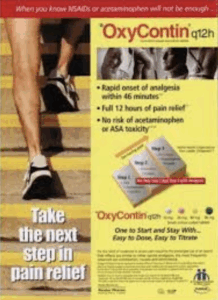
You turn on the television and one of the first things you see is an advertisement for a new drug. A man walks into a coffee shop, where his order is already sitting on the counter, ready for him. He says hello to his favorite Barista and drops a tip in the jar. He then takes a walk through the quaint neighborhood, petting the dog that walks by, and admiring the view. During this scene, a pleasant voice plays in the background talking about how, by taking this medication, you can also relieve your early-stage Alzheimer’s symptoms, slow your chronic kidney disease, or ease the burdens of Huntington’s disease symptoms. An artful creation, painting the picture of hope. Pharmaceutical companies target people’s innate desire for relief and safety by giving what is, in most cases, false hope.
These advertisements not only offer false hope, but they also create a narrative that taking these drugs is completely safe and risk-free. The most notorious example of this is Purdue Pharma’s advertisement campaign for the highly addictive opioid OxyContin. OxyContin was marketed as a great option to treat pain, so great that people should request that their doctors prescribe it to them. This advertisement for OxyContin features a respectable-looking man. He has a calm, assuring demeanor as he informs consumers not to be afraid of using OxyContin because it is completely safe. Standing tall is his freshly pressed suit and reliable appearance, explaining how “Less than 1% of patients become addicted” to opioids. This drug helped to fuel one of the biggest problems in the United States. According to USA Facts, in 2018, there were 670,000 people seeking treatment for opioid addiction in America. Remember, this figure does not include the numerous people who lack the resources to receive treatment that they never needed before their prescribed wonder medicine.
So, we have people in the worst pain of their lives, individuals who are desperate for treatment, and those with no hope left at all. These are the individuals who are ripe for exploitation by pharmaceutical companies. These companies utilize their overflowing checkbooks to create alluring, convincing advertisements to attract people to seek out their drugs. To become loyal, addicted customers or consistent users because they believe it might be helping their condition. Hundreds of thousands, if not millions, of Americans have and will continue to fall victim to these crimes, which are playing in the background as your family is eating dinner together.
Art is being weaponized in an extremely deceptive way. Innately trustworthy tones, carefully selected coloring, hand-picked diction, and much more come together to persuade people that they need to take this drug. Hiding any harm in patient’s soft spots, the perfect crime that the majority don’t even realize is occurring, all while the companies’ shareholders gain a profit.







